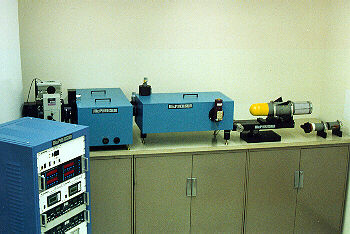
UV-VIS-IR Spectral Test Station for Calibration and Measurement
This system was originally developed to determine detection ranges of heat seeking and light guided missiles. It meets the challenge of analyzing spectral sensitivity of detectors under development or in devices of unknown origin. It also serves as a spectral photometer if the large 5 inch (125 mm) monochromatic sample beam is used to measure transmissivity, reflectance or fluorescence of unusual samples.
This spectrometer uses reflective mirrors throughout the optical system and offers high resolution, high throughput, and optimized wavelength coverage.
The 190 nm to 20 micron selectable and scannable spectral energy emerges and reaches the sample stage in the form of a >125 mm collimated beam. This beam can be optically treated to also illuminate smaller sample areas.
Data sheet
| Optical Design | Czerny Turner design Monochromator / Spectrometer |
| Focal Length | 350 mm |
| Aperture Ratio | f/4.8 (NA 0.1) |
| Wavelength Range | refer to grating of interest for range |
| Wavelength Accuracy | ±0.2 nm |
| Wavelength Reproducibility | ± 0.05 nm (with 1200 G/mm grating) |
| Grating Size | 68 x 68 mm (single grating holder, optional dual-grating turret) |
| Slits | Micrometer adjustable width 0.01 to 4 mm, height settings from 2 to 20 mm |
| Slit Locations | Axial and lateral, with optional port selection mirrors |
| Focal Plane | 25-mm, multiply dispersion by the width of your detector for range |
| Grating Groove Density (g/mm) | 3600 | 2400 | 1800 | 1200 | 600 | 300 | 150 | 75 | 50 |
| Spectral Resolution at 312.6nm (nm, FWHM) | 0.02 | 0.025 | 0.035 | 0.05 | 0.1 | 0.2 | 0.4 | 0.8 | 1.2 |
| Reciprocal Linear Dispersion (nm/mm) | 0.7 | 1 | 1.5 | 2 | 4 | 8 | 16 | 32 | 48 |
| Wavelength Range from 185nm to | 430 | 650 | 865 | 1.3 um | 2.6 um | 5.2 um | 10.4 um | 20.8 um | 31.2 um |
| First Order Littrow Blaze (nm) | 240 | 240 | 180 | 200 | 250 | 280 | 300 | 2 um | 600 |
| holo | 300 | 250 | 300 | 300 | 300 | 500 | 3 um | 12 um | |
| holo | 400 | 400 | 500 | 500 | 800 | 8 um | 14 um | ||
| holo | 500 | 750 | 750 | 1.25 um | 10 um | ||||
| 750 | 1 um | 1 um | 2.5 um | 12 um | |||||
| 1 um | 1.8 um | 3 um | 4 um | ||||||
| holo | holo | 4 um | 6 um | ||||||
| 8 um | |||||||||